A practical guide to using AI in your job hunt
The ultimate guide on how to stand out as an applicant while saving dozens of hours in the process
✨ Hey there this is a free edition of next play’s newsletter, where we share under-the-radar opportunities to help you figure out what’s next in your journey. Join our private Slack community here and access $1000s of dollars of product discounts here.
I enjoy finding people who have discovered “useful secrets” and sharing those with the community. Today, I am excited to share some of Torsten Walbaum’s helpful secrets. Torsten previously spent time at places like Uber, Meta, MIT, and Rippling, and he’s also the author of the Operators Handbook.
He wrote 6000+ words of advice you can learn from — all about how to practically (and productively!) use AI during your job hunt.
Hope you enjoy and find it useful.
Looking for jobs is a lot of work.
You need to research companies you’re interested in, hope they have job openings that match your profile, customize your application to them, and then prepare for and ace interviews.
And even if you get an offer, you’re not done: You still need to negotiate and, if you’re lucky to get multiple offers, decide which one to take.
Since all of this is so much work, most people opt for one of two extreme approaches:
Approach #1 (“Quantity over Quality”): Apply to hundreds of jobs with a generic application hoping that the large volume will yield at least a few positive responses
Approach #2 (“All Eggs in One Basket”): Focus all of your time on one or two applications to dream companies, hoping that the massive effort will let you stand out
Unfortunately, neither approach is great. The first approach will burn through a lot of good opportunities with subpar results because you’re not putting your best foot forward with each individual application. In a competitive market, that’s a recipe for disappointment.
In the second approach, you’re ignoring the fact that even if you’re a great candidate for a role, there’s always luck involved; relying on a small handful of applications means there’s a real chance you won’t get any interviews or job offers, even if you’ve polished everything to perfection.
So, what should you do instead? Luckily, nowadays there’s a third option that allows you to combine the best parts of both approaches above:
Use AI to identify high-fit companies and automate the grunt work so you can build a strong top of your application funnel, and then customize each application to maximize your chances of getting an interview and finally an offer.
In this post, we’ll go through exactly how to do that, including detailed prompt examples you can use immediately. Specifically, we’ll cover how to use AI to:
Figure out what type of role is the ideal fit for you
Automatically find jobs that match your exact criteria
Stand out in your applications with a customized resume and unique portfolio
Identify hiring managers to avoid the ATS
Be prepared for any interview question you might get
Assess and negotiate offers to get the best terms possible
Let’s dive in.
Phase 1: Preparing for your job hunt
🎯 Goals:
Figure out what jobs you want to apply to (the basis for your future “outbound” efforts), and
Increase your visibility to generate some “inbound” interest
🤖 AI use case #1: Using AI as an advisor to find your dream role
Almost everyone I know in tech that loves their job got it through some sort of coincidence. They met someone who had an interesting job and applied for similar roles, or they took an internal transfer opportunity to another team.
That’s not crazy if you consider that most tech roles are fairly new and university career advisory programs etc. don’t really know much about them. But in the age of AI, we don’t have to wait for serendipity anymore and can take a more intentional approach.
As long as you share the right context, AI chatbots are great at giving you targeted recommendations for roles you might like. Here’s a template you can try (just replace the parts in bold with your information):
I'm currently a [current or previous role] at a [type of current or previous company]; my resume is attached. I like parts of my job like [things you enjoy], but am frustrated by [things that drain your energy].
What career paths could I pursue from here where I can double down on my strengths but can address some of the pain points listed above? Please ask me questions for more context as needed to give a customized answer.
In the example below, I used this prompt to explore options for a BizOps manager that wants more ownership. After asking me a few clarifying questions, ChatGPT suggested three roles that fit my criteria.
Full example answer from ChatGPT
In addition to a succinct overview, it also gave more detail on what you’d actually do day-to-day in these roles, why they might be a good fit, what to watch out for, and how to choose among them.
🤖 AI use case #2: Ask AI to review & optimize your LinkedIn profile
Having an up-to-date, optimized LinkedIn profile is helpful for at least two reasons:
You might get “inbound” job opportunities, i.e. recruiters might find your profile and reach out proactively
Hiring managers often take a quick look at it when screening resumes
If you’re like me, though, you probably hate keeping your profile up to date. Luckily, you can massively reduce the time it takes by asking AI to review and feedback your profile and then implementing the handful of suggestions that seem most promising.
A simple prompt like this will already give you plenty to work with:
I am currently looking for [type of role you’re targeting] opportunities. Please review my LinkedIn profile ([your LinkedIn profile URL]) and suggest opportunities for improvement that would increase my chances of getting inbound job offers from hiring managers or recruiters.
I also attached screenshots of my profile in case you cannot access it on LinkedIn.
When I did this for my profile, Perplexity correctly concluded that I was missing key pieces; e.g. I wasn’t highlighting all relevant skills or properly showcasing the impact I drove in my past roles.
Note: Since the AI is trained on a lot of influencer content, it tends to include a few suggestions that are not to everybody’s taste (e.g. I don’t want to use a super long “influencer-style” headline like Perplexity proposed).
Just pick the pieces that you’re comfortable with and can implement with reasonable effort.
Phase 2: Looking for open jobs
🎯 Goal: Compile a list of open jobs that fit your criteria with minimum manual effort
Mental model: Treating your job hunt like a funnel
I recommend thinking about your job search as a “funnel”; regardless of how strong your profile is, you need to apply to a lot of jobs to get at least one offer at the end.
Example: Let’s say in an optimistic scenario, you hear back from one out of five applications you submit, and you get an offer from one out of five interview processes you go through. That means you’d need 25 applications for just one offer.
And in reality, “conversion rates” often look even lower than that. So I recommend you aim to compile at least 50 - 100 job openings to start; then, you can work through them step-by-step starting with the most attractive ones.
🤖 AI use case #3: Compiling a master list of open jobs
Communities like Next Play are awesome to get access to a constant stream of relevant opportunities. But if you want to build a strong top-of-funnel for an active job search, you need to complement this with proactive research.
However, searching Google or job boards manually can be very time consuming, and extremely frustrating. For example, when I googled “Strategy” jobs and found this listing from Google itself, it didn’t have a link to the careers page; instead, it just linked out to a bunch of job portals:
Which then required me to create an account before getting to the actual job listing:
That’s why I recommend outsourcing this work to AI. This way, you can get a list of curated job opportunities with links directly to the ATS postings or company career pages.
The research functions of ChatGPT, Claude etc. are not a great fit here because they use a lot of cached results and will often give you lists of outdated job postings. Perplexity, on the other hand, does a decent job if you explicitly tell it to focus on live, verified listings on ATS systems:
<goal> Please create a list of high-growth companies and open [type of role you’re looking for] job postings based on the criteria listed below </goal>
<context> [List your criteria like location, salary range etc. here] </context>
<structure> Please provide the output in a table, with one row per job posting.
Include, at least the following columns:
[Add the things you want included in the list, e.g. company name & description, job location, salary etc. and mark them as “must have” or “optional”]
<instructions>
1. Please check all links and make sure they're working; don't include broken links / expired job postings. THIS MEANS THAT LINKS SHOULD LEAD TO A LIVE PAGE OF A SPECIFIC JOB, NOT 1) REDIRECT TO THE OVERALL CAREERS PAGE OR 2) THROW A 404 ERROR.
2. Please prioritize postings on ATS systems like Greenhouse, Lever and Ashby over other sources like LinkedIn or company websites. </instructions>
Here’s an example output report based on a Product Manager job search (most of the listings are probably offline by the time you’re reading this, but they were all working at the time of the search).
You’ll get even better results, though, if you have a premium subscription to ChatGPT and use Agent Mode. I recommend the following workflow:
Step 1: Ask your favorite AI tool to compile a list of 30 - 50 high-growth startups that fit your criteria (e.g. certain company stage, industry etc.) and download it as a CSV
Step 2: Feed that list into ChatGPT Agent Mode and ask it to compile a list of 50+ live job postings that match your criteria, using the company list as a starting point:
I am looking for [your target role] opportunities at high-growth startups. I have about [X] years of experience, and am considering roles in [your location preferences].
Please conduct an in-depth search of relevant job boards, company career pages and ATS systems (Greenhouse, Lever, Ashby) and generate an exhaustive list of current job openings.
- Aim to include at least 50 relevant job postings including key information like job title, company, salary range (if mentioned), years of experience (if mentioned), location, a link to the job posting etc.
- Make sure all the job postings are still live, i.e. test all of the links to job posts you include
To get you started, please use the attached list of high-growth startups. You don't have to limit your search to these companies, but they could be a good jumping-off point.
This is what I got back from ChatGPT after ~20 minutes when asking for BizOps roles with an AI focus:
It’s not perfect (e.g. a few of the job postings don’t adhere to the location restrictions I gave and some roles are too junior), but overall it’s a great starting point and only took me less than 5 minutes of work.
Phase 3: Applying for jobs
🎯 Goal: Become a stand-out candidate with a customized application with minimal time investment
Even if you’re applying for many jobs, you should aim to customize each application to maximize your odds of getting an interview.
Obviously, you won’t have time to do this completely manually and put in the same amount of effort for every application. That means you need to:
Use AI to automate as much as possible
Stack-rank the jobs so you can focus your effort accordingly
Then, you can do the bare minimum customization for every single application and put in extra effort to stand out for the top ~5 jobs you’re most interested in.
AI use case #4: Optimizing and customizing your resume & drafting cover letters (if required)
Before you start tailoring your resume to specific positions, it’s a good idea to give it a generic overhaul to make sure it adheres to best practices like focusing on the impact you drove rather than responsibilities you had in each role.
Resume best practices are well-documented, so LLMs have lots of relevant training data and can give you a solid assessment:
Please review my attached resume and provide a list of suggestions for improvement.
1. First, briefly summarize the overall opportunities for improvement following the pyramid principle
2. Then, highlight specific bullets that need improvement and give detailed feedback, explaining your reasoning
This version will then be the basis for the next step: Customizing your resume to highlight the most relevant things for each application.
To do this, first create a document with all of the job postings you’re planning to apply to. Then, if you want to go the extra mile, use Deep Research to gather more information on the companies (see below under use case #7 for tips and prompt examples).
Finally, upload the document with the job postings, the report from Deep Research (if you have it), and your generic resume and ask your favorite LLM (I use ChatGPT) to do the following:
<goal> I want you to take the attached resume and propose how to tailor it to each job in the attached document. For each job, propose what to add, change or delete from the “generic” resume. </goal>
<instructions> When you’re proposing to add or change something, describe in detail what would be ideal, but also give several alternatives. For example, for a GM-type role, it might be most impactful if I had founder or P&L ownership experience to highlight; but I might not have that, and would need other “slightly-less-ideal but still helpful” suggestions of what to do instead. </instructions>
Note: I don’t recommend having the AI directly create customized resumes for you, for a simple reason: It doesn’t have any context besides what’s already in your resume.
So in cases where it would be good to highlight additional relevant skills or experiences, it would have to make something up. As a result, it’s better to use AI to get feedback on what you can improve, and then implement those improvements yourself.
Finally, if the job posting is asking for a cover letter, AI can help with this. Here’s my rule of thumb:
If there is a generic requirement to attach a cover letter, it’s fine to use AI to help write it. Chances are, the hiring manager won’t read it (or use AI to summarize it)
However, if the job posting specifies exactly what the cover letter is supposed to focus on (e.g. highlighting your biggest achievement, or answering a strategy question), you should always write this completely yourself. The point of these types of cover letters is to stand out, so you’ll want it to reflect your unique experience, personality, and style
AI use case #5: Creating deliverables that let you stand out
99% of applicants send in just a resume (plus a cover letter, if required). And you can definitely get jobs that way, even today.
But: Doing something special massively increases the odds that you get noticed, and that’s especially important if you’re recruiting in an area where there aren’t that many openings (and therefore you won’t get that many “shots on goal”).
The first step is to come up with ideas. You can use any general-purpose AI chatbot for this, but I personally find Claude particularly helpful.
I'm applying to [type of company you’re targeting] and am thinking about ways to stand out. I'm considering doing [your current ideas]. What do you think of this, and what other ideas with a high impact-to-effort ratio can you think of?
Example transcript from Claude
The more context you add, the better the results will be. I recommend adding the following to the base prompt above:
How much time you can dedicate to this
Links to specific job listings you’re considering, and/or a summary of what skills you want to demonstrate
Whether you’re willing to create something tailored to each specific company, or want a deliverable that you can use for a bunch of similar roles
And if you’re not happy with the first set of ideas or just want more, keep pushing back until you’re satisfied.
Then, it’s time to implement your chosen idea(s). Which AI tool you should use, if at all, depends on the specific idea. Let’s take some examples from the list of ideas Claude generated above for standing out in AI PM applications:
Create a "PM tear-down" video/Loom: I’d recommend doing this kind of thing without AI. Any time you want to stand out via a unique point of view, it’s best to not outsource the work
Document user pain points with evidence: For this, I’d use AI to scrape X, Reddit, review sites (G2 etc.) and then create the final report manually
Ship something small but public: Use Lovable or Vercel V0 to create a website or simple prototype; this takes a bit more time, but you can make this industry- instead of company-specific so you only have to do it once (e.g. if you create a repository ranking AI tools by use case, you can use it for applications to any AI company)
AI use case #6: Identifying hiring managers
While it doesn’t work every time, messaging hiring managers directly instead of going through the regular application funnel can increase your chances of getting a foot in the door (esp. if you combine it with a unique tactic to stand out from above), so it’s worth giving it a shot.
Perplexity does a decent job at this by browsing company websites as well as LinkedIn profiles and posts. If you give it a list of jobs as a CSV together with this prompt…
<goal> Please find the hiring managers for each job post in the attached CSV </goal>
<output> Please provide a table listing the job postings I provided, and one (or multiple) LinkedIn profiles that might be the hiring managers for each one. Please also include a brief summary of your reasoning w.r.t. why you think this person might be the hiring manager </output>
<example> For this job [add example], it looks like [add example hiring manager and their LI profile] could be the hiring manager because [add reasoning]. Please find similar matches for the other jobs </example>
<instructions> Don't just rely on the job title; please check out the full job posting behind each application link and use the information there (e.g. what team the role is on, what the role does etc.) to identify the likely hiring manager.
If you can't find a likely hiring manager, please list the likely skip-level (e.g. overseeing the entire group) and/or potential peers on the same team.
Please keep it close to the role; i.e. don't list the CEO, CPO or another high-level exec as the hiring manager unless it's a small startup and it's likely that they would be directly involved in hiring for this type of role. </instructions>
… you’ll get back a list like this:
Full example report from Perplexity
In some cases, it didn’t find a good candidate, but other times it was spot on (e.g. it found a PM lead promoting roles on the exact team that the job opening was on).
Phase 4: Preparing for interviews
🎯 Goal: Deeply understand the company, anticipate likely questions, and practice how to solve them
Using AI for interview prep might be the most underrated use case. There are specialized tools, but the general-purpose ones like ChatGPT and Claude can get you very far.
AI use case #7: Researching the company
With AI to help you research, there is no excuse anymore to show up to an interview unprepared. Many candidates still do, though, so if you deeply understand what the company does and how it’s positioned etc., you’ll definitely stand out.
I recommend using ChatGPT Deep Research to look into the following:
💰 What products or services the company offers and how it makes money
🔎 How the company is positioning itself, how it’s differentiated from the competition, and where its offering is stronger or weaker
📢 How it markets and sells its products
🚀 Current focus areas and new bets
Here is what an effective prompt for this looks like:
<goal> Please put together an in-depth report on [company] that I am interviewing with for a [role you’re interviewing for] role. </goal>
<content> At a minimum, please cover the following in separate sections:
[insert the bullets from above and/or any areas you want to learn about]
<style> Follow the Pyramid Principle: State key takeaways or recommendations first, then add supporting arguments and data where appropriate. Use bullet points, overview tables and other formatting to make the report easy to parse. </style>
<instructions> In addition to the company website, news articles etc. please also leverage the following types of sources:
- Founder interviews from the last year (e.g. to understand how they’re thinking about current opportunities and challenges)
- Case studies from leading industry blogs
- [If public company] Earnings presentations
Please cite a source in-text for any claim you make </instructions>
And you’ll get back an in-depth report like this:
Full report from ChatGPT Deep Research
Note: You can also get ideas for questions you can ask during the interview process from the report. Getting some inspiration this way is fine; but I highly recommend you do your own thinking as well.
Asking questions is the opportunity to show genuine curiosity and how you’re thinking about the company, so try to be authentic instead of just reciting what AI came up with. They want to hire you, not Claude or ChatGPT.
AI use case #8: Researching the interview process
The second important area you should dig into is the interview process itself. Especially if you’re applying for larger companies that have been around for a while, there will be a lot of information online that AI can find.
Here’s how you can get an actionable overview via the Deep Research feature in the tool of your choice:
<goal> Please create an in-depth report on the interview process for [type of role you’re interviewing for] roles at [company]. </goal>
<content> Please cover at a minimum:
- How many rounds and what types of interviews the process typically entails, and who I’d likely be speaking with in addition to the hiring manager
- Questions that have been asked in the past
- Whether any take-home exercises seem to have been used
- Whether interviews are typically remote or on-site
- How long it took for people to hear back </content>
<instructions>
- Prioritize information from 2025 wherever possible
- Highlight any variance in what people report
- If you can’t find information on something, clearly say that – don’t make things up. It’s fine to make reasonable assumptions or inferences based on available information as long as you clearly state them
- Aim for a high level of detail and at least 3,000 words </instructions>
Now, instead of browsing dozens of websites or forum posts, you can just read one single, dense report:
Example report researching the Data Science interview process at Meta
You’ll still have to practice (see below), but it already helps a lot to feel like you’re deeply familiar with the process and know what types of questions to expect.
When you pull up to the interview after researching likely questions
AI use case #9: Practicing interview questions
🎯 Goal: Practice in a low-stakes environment until you’re confident you can handle any type of question
In the early years of my career, practicing interviews was painful. You had to find and coordinate with others to practice behavioral and case study questions, and practicing hard skills like SQL meant taking clunky and generic online courses that had little in common with what you’d actually be asked to do in interviews or on the job.
With AI chatbots, this process is so frictionless it can actually be fun. My favorite tool for this is ChatGPT, but Claude and others do a decent job, too.
To get started, the very first thing you should do is to give custom instructions. Without them, AI is often too encouraging, so if you want to pressure-test your approach as much as possible before the real interview, you have to configure it to be a bit more critical:
Then, share the exact job opening you’re interviewing for so the AI can provide customized responses.
Once you’ve done the above, you can practice literally anything. For example:
Behavioral questions
Ask the AI to come up with likely behavioral questions, answer them (e.g. via voice mode), and then ask it to help you fine-tune how you deliver your anecdotes to perfectly demonstrate the relevant skills.
Practice coding or SQL
Even though this is not a built-in feature in general-purpose LLMs like ChatGPT, you can create your own training environment with a simple prompt.
Let’s say you want to practice SQL, and you’re applying for an e-commerce company. This prompt will allow you to practice SQL right in the chat interface and get detailed feedback to help you improve quickly:
I am applying for a Product Manager position at an e-commerce company and want to practice SQL since it’s a desired skill in the job posting.
Please generate example data tables that an e-commerce company would have (with hundreds of rows of data), show me a preview snippet of each one so I know how they’re structured, and then give me a practice question to solve. I will write the SQL, and you will then “run it” and return the results to me. If the query contains an error and wouldn’t run, give me an error message.
Please only give hints when asked for help.
Practice case studies
Whether you’re applying for BizOps, Chief of Staff, Product Management, Growth, or Analytics positions, chances are you’ll be given a case study. This can take different shapes; for example, on the interview day, you might be given an assignment to work on by yourself that you’ll then present an hour or two later. Or, you’ll be asked to work through a problem in real-time with an interviewer.
These types of interviews can feel high-pressure and, in my experience as both a candidate and interviewer, are often the ones that decide whether a candidate passes or not. The best (and frankly only) way to get good at them is to practice a lot, and AI makes this easy.
Let’s take the consulting-style cases where you need to solve a problem live. The key in these types of interviews is to structure your answer well and walk the interviewer through your thought process; that’s way more important than the actual answer you arrive at.
You can kick off a practice run with a simple prompt like this:
Then, after the AI gives you a brief overview of the case, there are several aspects you can practice:
Asking good clarifying questions: Interviewers often share very brief prompts to start, and expect you to ask for more context. I recommend you make an attempt, and then ask your AI “interview coach” what else you should have asked for
Creating a structure on the fly: The toughest part about cases is that you have to come up with a structured approach to solving them in less than 5 minutes. The only way to get good at this is to practice it a few dozen times:
Explaining your thought process: You can’t get points from the interviewer for anything that’s only in your head. Walking them through your thinking in a concise way is an extremely important skill, and AI gives you a low-stakes way to practice that
AI use case #10: Learning from mistakes
Interviewing is a skill like any other, so the same rules apply. Most importantly: Practice makes perfect.
Your first interviews will likely be challenging if it’s been a while since your last job hunt. But instead of seeing an interview that didn’t go as planned as a defeat, treat it as a learning opportunity.
After the interview is over, while your memory is fresh, take notes, focusing on the parts of the conversation where you felt the interviewer wasn’t satisfied. Include what you said, what the interviewer said, and any verbal and non-verbal cues you picked up on. The more detail, the better.
Then, dump this into a new AI chat and ask questions like:
“What do you think the interviewer was trying to get at that I was missing?”
“What other ways could I have approached this question?”
Phase 5: Negotiations and offer acceptance
🎯 Goal: Making sure you’re getting competitive compensation, understand the contract you’re signing, and know what kind of work environment you’re getting into
When you finally get an offer after putting so much effort into the process, take some time to celebrate.
But even if you’re excited, it’s usually still a good idea to take a few days to think about the offer and make sure you know exactly what you’re getting into before you’re accepting it. If a company is unwilling to give you at least a few days for this, it’s a red flag 🚩.
AI use case #11: Benchmarking compensation
For certain roles like Engineering, there are great resources like levels.fyi where you can get detailed compensation benchmarks.
But for almost everyone else, this doesn’t exist. Now, you can just straight up ask an AI chatbot to evaluate your offer. But in my experience, they’ll rely on one or two random sources, so it’s not a particularly robust assessment.
Instead, I recommend doing one of two things:
Option #1: Asking the Deep Research tool of your choice (ChatGPT, Gemini, Perplexity etc.) to compile a list of secondary sources (blog posts, one-off surveys, etc.) that have compensation benchmarks for the type of role you’re targeting.
This is lower lift, but the quality of these can be somewhat questionable (e.g. many surveys have small sample sizes or murky definitions).
Option #2: Use ChatGPT Agent Mode to compile a list of actual salary ranges from job postings from 1) similar companies with 2) similar years of experience.
Then, you can compare your own offer to these ranges to see which percentile you roughly fall into.
AI use case #12: Evaluating offer terms and drafting negotiation emails
In addition to compensation, you’ll want to understand the remaining key terms of your offer (e.g. option exercise periods, non-compete agreements, etc.).
If you’re not a senior executive, it’s unlikely you can negotiate most of these, but you’ll at least know what you’re agreeing to and whether it’s market standard.
Please review the attached offer letter for a [role] role at [company] and:
- Summarize key terms in plain English
- Highlight the things I should definitely be aware of (e.g. clauses that are restrictive or to my disadvantage)
- Evaluate the key clauses w.r.t. whether they are market standard, and give an assessment of how likely I’d be able to negotiate them given the role I’m interviewing for (and what I should be asking for instead). Be realistic; I only want to push for things that someone at my level would realistically be granted by a company like this
Note: Take the recommendations with a grain of salt. In my experience, AI is about 50/50 in this regard; sometimes it highlights valuable opportunities for negotiation, and other times it massively overestimates how much wiggle room there is. Ultimately, you’ll still have to use your own judgment to decide what to push on.
After you evaluate the contract, the next step is to ask for what you want, be it a change in contract terms or simply more time to decide while you’re finishing interviews with other companies. Either way, you need to write an email that makes a clear ask while also showing that you’re excited about the offer.
It can be a tricky balance, and it’s helpful to have someone proofread your writing and feedback the tone. I don’t recommend having AI actually draft these emails for you, but rather using it as a final check that the email comes across the way you intended.
At the risk of repeating myself, the most important thing here, by far, is context:
Who are you sending the email to, and why?
What are you hoping to get out of this ideally, and what outcomes would you still be happy with if you can’t get that?
What has happened and been discussed up to this point? [note: ideally share the email thread]
AI use case #13: Assessing the company culture and reputation
If a company isn’t a fit for you culturally, you won’t be able to do your best work. And chances are, you’ll leave before you can even vest your full equity grant.
It’s impossible to eliminate this risk completely, but doing some basic due diligence can massively reduce it. As a first step, I recommend talking to people who worked at your target company.
You’ll have the best chances of getting a response and an unfiltered view if you reach out to people who 1) are first- or second-degree connections of yours on LinkedIn (so they know you or you can get an intro), and who 2) left the company recently (so they’ll talk more freely).
You can do this easily by selecting the corresponding search filters on LinkedIn:
If you can’t find anyone in your network this way, or you want more data points, you can use AI to sift through forums like Reddit, Blind etc. and synthesize what people like and dislike about working there.
Perplexity is my go-to for this since you can select what types of sources you want it to focus on:
I’m interviewing with [company] for a [role] position, and am in the final interview stages. Before I accept an offer, though, I want to understand the culture better. Please create an in-depth report based on people’s experiences shared on Reddit, Blind, Glassdoor etc.
Please make sure to cover, among other things:
[Add any areas here that you’re concerned about; e.g. work-life balance, remote vs. in-office culture, growth opportunities, etc.]
TL;DR
Using AI to help in your job hunt isn’t about cheating, or letting the AI do everything end-to-end. Instead, the idea is to have a personal assistant and interview coach available 24/7 to remove a lot of the friction from the process.
You’re still at the center of it all; but since you’re outsourcing most of the grunt work, you can focus your time on the pieces with the highest ROI. Plus, you can apply to more jobs simultaneously without compromising when it comes to effort and customization.
I know job hunting can feel like an uphill battle at times, so hopefully this guide helps level the playing field a bit.
[1]
P.S. Some of you might be wondering if using AI in this way is “cheating”. My answer is a definitive “No”:
- I’m not suggesting you use AI to cheat during interviews, or use it to write deliverables that are supposed to showcase your thinking, but rather to automate a lot of the grunt work that comes with job hunting
- Top-tier companies want to hire AI-fluent people, so using AI creatively like this is an argument in your favor
- Companies use AI to screen applicants, so using AI as a candidate only levels the playing field
[2]
I find copy-pasting the actual content of the postings into a document safer than just using a spreadsheet with links since LLMs sometimes say they checked out a link but didn’t actually do it.











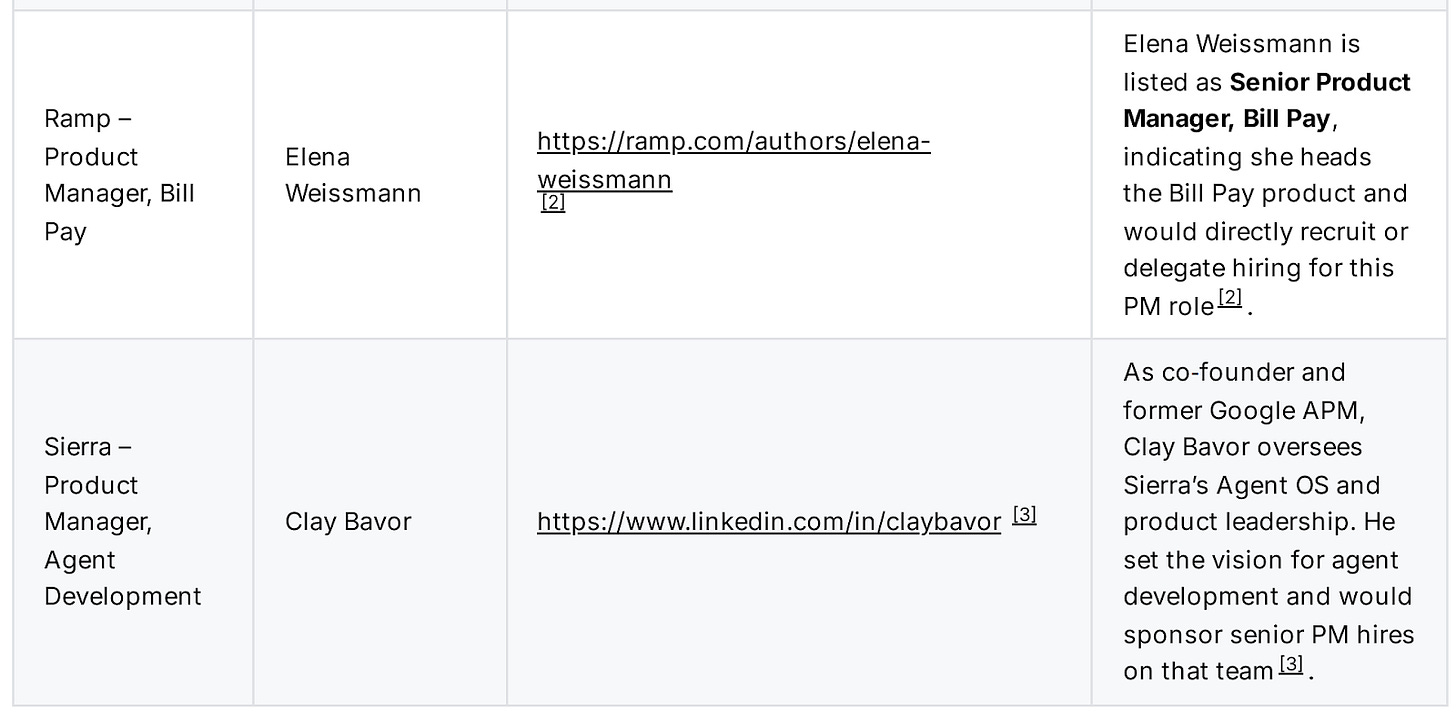



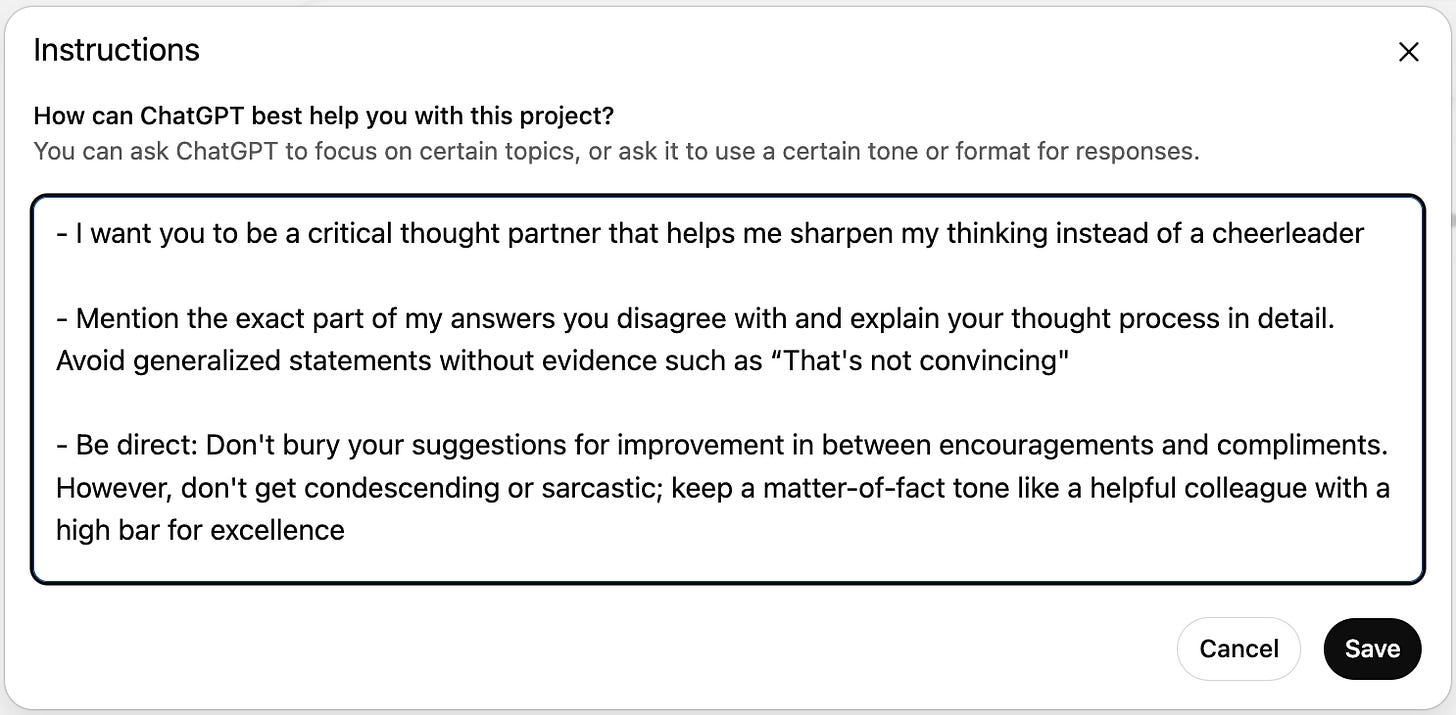
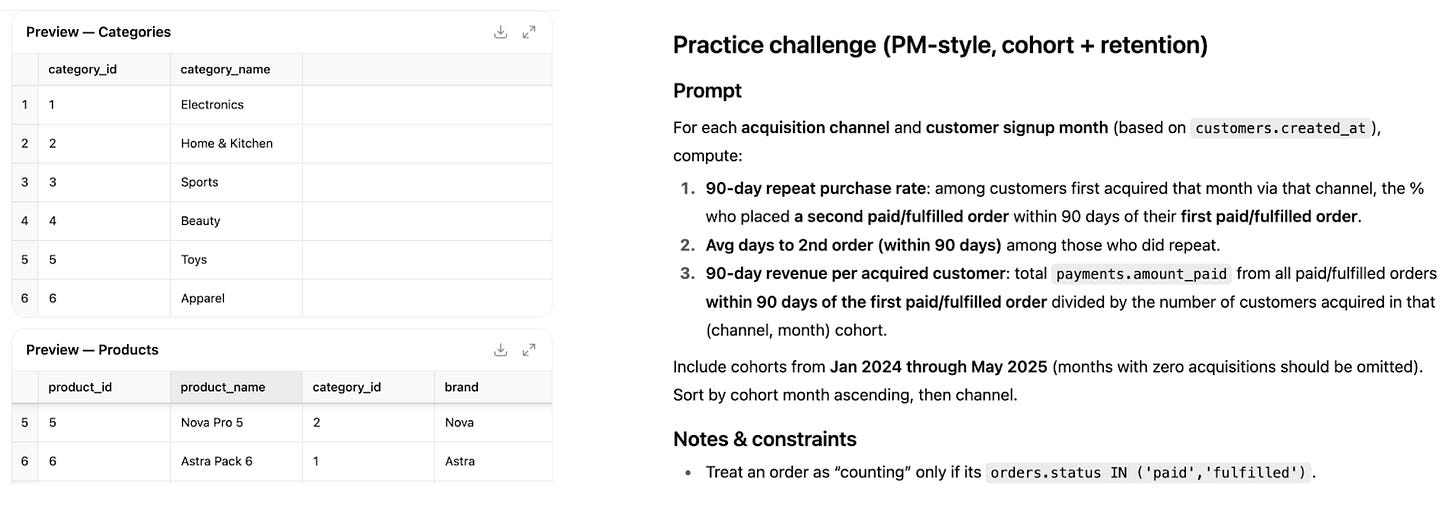


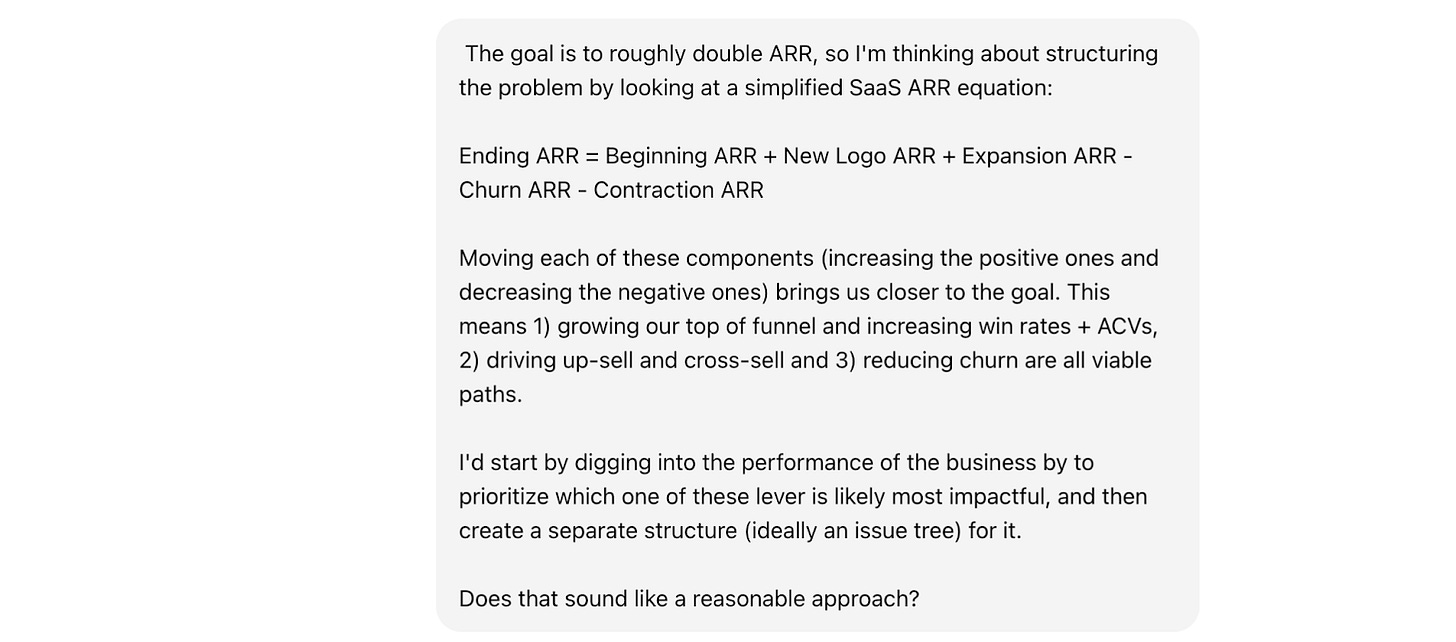

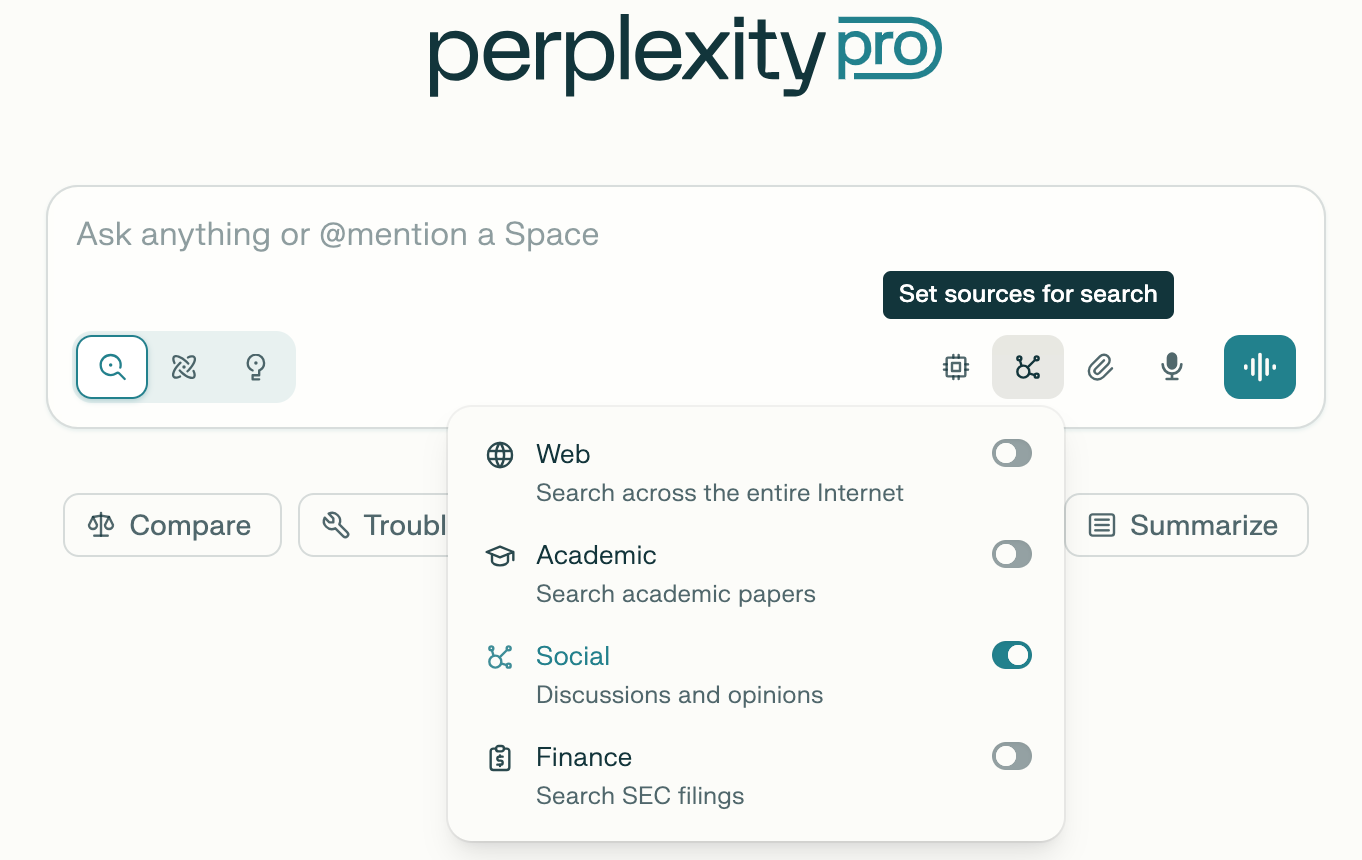

Love this guide! Another technique I've used at Phase 1 was this prompt, suggested by Austin Belcak at Cultivated Culture:
“I am struggling with gaining clarity on which career paths are right for me. I’m attaching my resume here.
Please craft a 10-20 question assessment that covers a wide range of topics including my background, interests, skills, things to avoid, and anything else you feel is relevant.
Please ask me each question on at a time. When I answer, store my answer. At the end analyze all of my answers and share 3 different job titles / career paths that align along with a summary of why you feel each could be a fit.”
This is such a smart, timely guide, especially the emphasis on moving beyond the two flawed extremes of job hunting. The most successful applicants won’t be the ones who let AI write for them, but those who use it to work smarter, narrowing focus, tailoring messaging, and negotiating from a place of clarity. This could genuinely change how people approach career transitions.